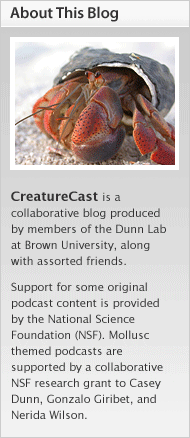-
May 19, 2014
The Mysterious Disappearing Cuttlefish -
May 19, 2014
The Evolution of Complexity -
May 19, 2014
A Tale of Two Sea Urchins -
May 19, 2014
If You Don't Have It- Steal It: Sea Slug Defenses -
February 18, 2014
Moving On Rainbow-Colored Legs: Cilia And Cteno... -
November 21, 2013
Ancient History: Tyrian Purple -
October 09, 2013
The Central Limit Theorum -
October 08, 2013
Sexual Dimorphism: The Spoonworm -
October 08, 2013
When Your Trash is Another's Treasure: Sustaini... -
September 04, 2013
Untangling DNA -
June 09, 2013
PhyloTree -
April 18, 2013
6 Tips for Achieving Invisibility -
February 28, 2013
Apolemia -
February 28, 2013
Chestnut Blight -
February 28, 2013
Nautilus -
February 28, 2013
Mud Skipper -
February 28, 2013
Glaucus atlanticus -
October 18, 2012
The Vertebrate Vascular System -
October 11, 2012
3D Printed Nematocyst -
September 20, 2012
Narcomedusae -
September 12, 2012
Doliolids -
September 12, 2012
How to Hide -
September 12, 2012
Ocean Slime -
July 05, 2012
Zoostalgia -
March 16, 2012
Echinoderm Skin -
March 16, 2012
Rhizocephala -
March 16, 2012
Jumping Spider -
March 16, 2012
Lifecycles, by Manvir Singh -
March 16, 2012
Anglerfish -
March 16, 2012
Tardigrades -
March 16, 2012
Resurrection Fern -
September 14, 2011
Passing Cloud -
June 02, 2011
Gelatinous Animals -
May 23, 2011
Hollow Trees -
May 23, 2011
Postdoc Position Available in the Dunn Lab -
May 11, 2011
Life on a Lobster Mouth -
May 04, 2011
Exciting Announcement -
March 08, 2011
Antartic Krill Love Dance -
January 28, 2011
Gyrodactylids -
January 18, 2011
Chasing Ghosts in Aotearoa -
January 10, 2011
Tangled String -
January 06, 2011
Waiting for the Bus -
January 04, 2011
Practical Computing for Biologists -
December 14, 2010
The Stomatopod Strike -
December 03, 2010
Moray Eel -
November 01, 2010
Gone Fishing -
October 26, 2010
Perspective of a Bird -
October 07, 2010
Know Your New England Bioluminescants -
October 01, 2010
Jellyfish Capsule Hotel -
September 20, 2010
Siphonophore Snacks -
September 08, 2010
What is a Cell? -
August 12, 2010
Corals and Coloniality -
July 20, 2010
Jellyfish Theater -
July 16, 2010
Axolotls and the French Intervention -
July 07, 2010
More Budding Jelly Babies -
June 24, 2010
Salty Pups -
June 17, 2010
Centerless Self -
June 08, 2010
How Do Krill Grow? -
May 26, 2010
Bone Boring Worms -
May 17, 2010
A Tale of Two Nuclei -
May 07, 2010
Be Still Its Beating Heart -
April 30, 2010
CreatureCast – Sea Stars -
April 22, 2010
Seeing the Invisible -
April 09, 2010
CreatureCast – Individuality -
March 30, 2010
Hitching a Ride -
March 18, 2010
Tube Vision -
March 08, 2010
CreatureCast – Diving for Jellies -
February 18, 2010
After the Fall -
February 10, 2010
Solar Powered Sea Slugs -
January 27, 2010
CreatureCast – Picky Females -
January 20, 2010
Spicules and droplets -
January 14, 2010
CreatureCast – Pattern Shifting Snails -
January 11, 2010
CreatureCast – Comb Jellies -
January 07, 2010
Stack of plates in action -
December 29, 2009
Making babies like a stack of plates -
December 23, 2009
CreatureCast – Marine Worms -
December 22, 2009
Pelagic plastic -
December 18, 2009
CreatureCast Episode 3 -
December 17, 2009
Thou shalt covet thy neighbor’s cnidocytes -
December 16, 2009
The art of knotting -
December 09, 2009
Star colonies of sea squirts -
December 08, 2009
Postdoc position in the Dunn Lab -
December 02, 2009
Mating when you are stuck to a rock -
November 20, 2009
Deadly bands -
November 12, 2009
Mitochondrial lenses -
November 09, 2009
Marnix Everaert -
November 06, 2009
A tale of two holes -
October 30, 2009
Fall in Rhode Island -
October 28, 2009
Glowing worms in the deep sea -
October 26, 2009
Hiding submarines beneath jellyfish -
October 22, 2009
Retractable spots -
October 20, 2009
Evolution by co-option
« Prev « Prev Next » Next »




 A couple of months ago Casey Dunn talked about
A couple of months ago Casey Dunn talked about  Vaucheria (pictured right), the alga that is eaten by
Vaucheria (pictured right), the alga that is eaten by 

















